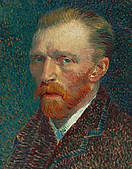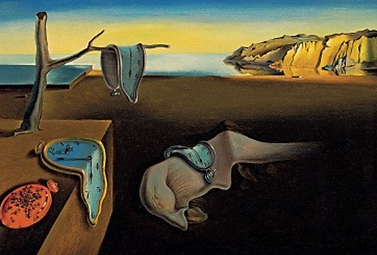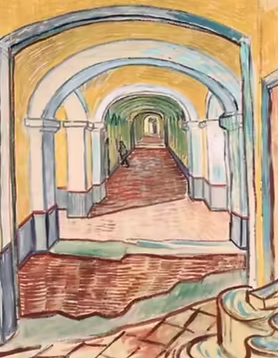Historica
“A generation which ignores history has no past and no future.”
Robert Heinlein, American author (1907-1988)
Vincent van Gogh: A Life of Passion and Torment
Vincent Willem van Gogh (1853–1890) was a Dutch Post-Impressionist painter who is widely considered one of the most famous and influential figures in the history of Western art. In just over a decade, he created more than 2,100 artworks, including approximately 860 oil paintings. Despite his immense artistic output, his work was not commercially successful during his lifetime, and he struggled with severe mental illness, which ultimately led to his premature death at the age of 37.

Early Life and Artistic Beginnings

Vincent van Gogh was born on March 30, 1853, in Groot-Zundert, a village in the southern Netherlands. He was the eldest of six children born to a Protestant minister, Theodorus van Gogh, and Anna Cornelia Carbentus. As a young man, he worked as an art dealer for the firm Goupil & Cie, where his uncle was a partner. This experience exposed him to a wide range of art, but he grew to dislike the commercial aspect of the trade and was eventually dismissed.
After a brief stint as a teacher and a bookseller, he pursued a calling to become a lay preacher in a poor Belgian mining community. It was there that he began to sketch and draw, inspired by the harsh lives of the miners. His passion for art grew, and with the financial support of his younger brother, Theo, he decided to become a full-time artist in 1880.
Artistic Style and Key Works
Van Gogh's artistic career was remarkably short, lasting only about ten years, but it was marked by a rapid and profound evolution in style. His early works, such as The Potato Eaters (1885), were characterized by a somber palette of earth tones and a focus on peasant life, reflecting the Dutch Realist tradition.
In 1886, he moved to Paris to live with Theo, where he was introduced to the vibrant colors and techniques of Impressionism and Post-Impressionism. He also became fascinated by Japanese woodblock prints. This period saw a dramatic shift in his style; his palette brightened considerably, and he began to experiment with the short, broken brushstrokes of the Impressionists.
The pinnacle of his style, however, came during his time in Arles, in the south of France, which he moved to in 1888. Here, under the bright sun of Provence, he developed the distinctive, expressive style for which he is most known. He used thick, textured brushwork (impasto), bold colors, and swirling, dynamic compositions to convey emotion and a subjective experience of the world. It was during this period that he painted some of his most famous masterpieces, including:
-
Sunflowers (series, 1888)
-
The Yellow House (1888)
-
The Café Terrace at Night (1888)
-
Starry Night Over the Rhône (1888)
-
The Bedroom (1888)
His tumultuous relationship with fellow artist Paul Gauguin also took place in Arles and famously culminated in a breakdown in which Van Gogh severed part of his own ear.
Van Gogh's artistic career was remarkably short, lasting only about ten years, but it was marked by a rapid and profound evolution in style. His early works, such as The Potato Eaters (1885), were characterized by a somber palette of earth tones and a focus on peasant life, reflecting the Dutch Realist tradition.
In 1886, he moved to Paris to live with Theo, where he was introduced to the vibrant colors and techniques of Impressionism and Post-Impressionism. He also became fascinated by Japanese woodblock prints. This period saw a dramatic shift in his style; his palette brightened considerably, and he began to experiment with the short, broken brushstrokes of the Impressionists.
The pinnacle of his style, however, came during his time in Arles, in the south of France, which he moved to in 1888. Here, under the bright sun of Provence, he developed the distinctive, expressive style for which he is most known. He used thick, textured brushwork (impasto), bold colors, and swirling, dynamic compositions to convey emotion and a subjective experience of the world. It was during this period that he painted some of his most famous masterpieces, including:
-
Sunflowers (series, 1888)
-
The Yellow House (1888)
-
The Café Terrace at Night (1888)
-
Starry Night Over the Rhône (1888)
-
The Bedroom (1888)
His tumultuous relationship with fellow artist Paul Gauguin also took place in Arles and famously culminated in a breakdown in which Van Gogh severed part of his own ear.

Starry Night

Sunflowers

The Persistance of Memory

The Yellow House
Later Years and Death

corridor in the asylum
Following the incident with Gauguin, Van Gogh voluntarily committed himself to an asylum in Saint-Rémy-de-Provence. Despite his mental health struggles, this was one of his most productive periods. From his window, he painted what is arguably his most famous work, The Starry Night (1889).
In May 1890, he left the asylum and moved to Auvers-sur-Oise, where he was under the care of Dr. Paul Gachet. He continued to paint furiously, producing almost one painting a day. His final works, such as Wheatfield with Crows (1890), are often seen as reflecting his troubled state of mind.
Throughout his artistic career, Vincent was almost entirely supported by his younger brother, Theo, a successful art dealer in Paris. Their deep bond is documented in their extensive correspondence, which provides invaluable insight into Vincent's life and work. Theo provided not only a monthly allowance for Vincent's living expenses and art supplies but also unwavering emotional encouragement, even as Vincent's work struggled to find a market.
On July 27, 1890, Vincent van Gogh shot himself in the chest and died two days later, with his brother Theo by his side.
Theo's death and Van Gough's leagcy
Vincent's death had a devastating effect on Theo. Already in a fragile state, Theo's health deteriorated rapidly. He was hospitalized with a severe nervous breakdown and died just six months after Vincent, on January 25, 1891, likely from a complication of syphilis.
Though Vincent only sold one painting in his lifetime, his reputation soared in the years following his death, thanks in large part to the efforts of his sister-in-law, Johanna van Gogh-Bonger. Having inherited the massive collection of Vincent's paintings and letters, Jo dedicated her life to preserving and promoting his work, believing deeply in the genius that her late husband had always seen. She organized exhibitions and published the brothers' correspondence, which proved instrumental in establishing Vincent as one of the most important artists in history. Today, his paintings are among the most expensive in the world, and his unique style has had a profound impact on Expressionism and other modern art movements. He is celebrated not only for his artistic genius but also for the emotional depth and humanity of his work.

Written by Tina Dautova 18.04.2025